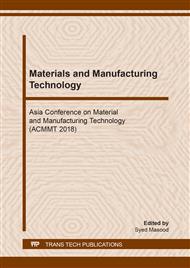p.9
p.15
p.21
p.29
p.37
p.43
p.49
p.59
p.67
Microstructure and Mechanical Properties of Copper-Iron Fabricated by Mechanical Milling and Continuous Sintering
Abstract:
This research is to analyze the effect of mechanical milling on the microstructure and mechanical properties of copper-iron. The sample is fabricated by compacting, milling and sintering processes. Sintering process is carried out using continuous type machine with conveyor belt mesh and the furnace type is muffle. After that, it is cooled with natural water jacket process. Vicker hardness testing and tensile strength test is performed to determine the mechanical properties of copper-iron alloys that occur. The mean value of sample 1 hardness (before milling) was 39.8 HV. The mean value of sample hardness 2 (after milling) was 74.9 HV. The value of the yield strength (σ) of sample 1 is 17.597MPa, and the value of ductility (ε) is 0.119. The value of the yield strength (σ) of sample 2 is 18.547 MPa, and the value of ductility (ε) is 0.073. The test results and analysis showed that by shrinking the size of metal powder, by milling for 2 hours, the hardness and yield strength of the product can increase. Although, the product becomes more brittle which is indicated by the decreased ductility value.
Info:
Periodical:
Pages:
37-42
Citation:
Online since:
August 2019
Authors:
Price:
Сopyright:
© 2019 Trans Tech Publications Ltd. All Rights Reserved
Share:
Citation:


